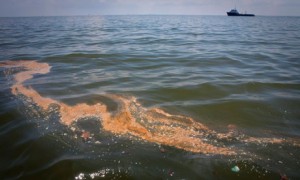
“Very Close Match” Between New Spill And BP’s Well
 A renewed push for permits by oil companies in the Gulf of Mexico is being overshadowed by a row over whether BP’s capped Macondo well is actually leaking oil.
A renewed push for permits by oil companies in the Gulf of Mexico is being overshadowed by a row over whether BP’s capped Macondo well is actually leaking oil.
If the well is somehow still leaking this would have major ramifications for BP, but also the wider industry that is gearing up for further drilling in the Gulf.
Nearly eighteen months after the disaster, some sixty per cent of rigs contracted in the Gulf of Mexico are still not working, a fact infuriating the oil industry.
Indeed for months BP has been paying $2.4m per day for five rigs on standby.
So you can see why the companies want to get the rigs back drilling, and the industry is due to meet regulators today to speed up the whole process.
But then there is the small problem of the small oil slick in the Gulf in the vicinity of BP’s disastrous Macondo spill last year.
For the last week or so there have been local press reports of an oil sheen in the area of the Macondo well. Under pressure to act, last Friday, BP and the U.S. Coast Guard’s Gulf Coast Incident Management Team, conducted a visual inspection of the well.
They concluded there was no release of oil from the well.
BP said that it had observed bubbles, but they were from cement ports near the site. “These observations are consistent with testing and sampling performed last year that detected nitrogen bubbles, a residual byproduct of the nitrified foam used in setting the wells’ surface casing cement,” the company said in a statement.
Jonathan Burton, commanding officer of the Coast Guard Marine Safety Unit in Morgan City also argued that: “Sheen sightings are frequent in the Gulf of Mexico and despite the fact each is fully investigated, the source cannot always be determined.”
However last week, journalists found bubbles of oil coming to the surface near the well and some was sent to be tested by Louisiana State University.
The university professor who did the analysis of the sheen says the oil “matches” that from BP’s Macondo well.
“They were a very, very close match,” Edward Overton, professor emeritus in the Department of Environmental Sciences at Louisiana State University told the Financial Times.
“If the composition in a sample and the spill are almost identical, we say that’s a match,” he said. “This is like looking across the room and picking out identical twins.”
Although the oil could be from well-head it could also be from the Deepwater Horizon drilling rig which sunk in the disaster. No one is quite sure yet.
But if it is found that the well-head is leaking – however small – that would be a disaster for BP.
